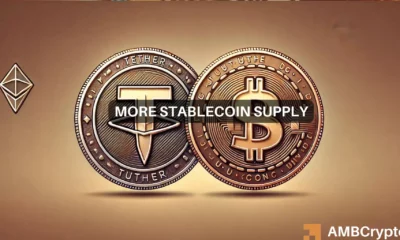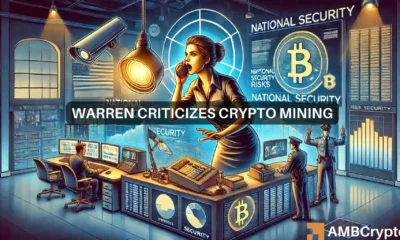Assessing how RWAs’ $16 trillion prediction can come true

“Killer use-case”
If you’re a part of the crypto-world, chances are you’ve heard this phrase repeatedly over the last 48 hours. Citi Bank’s latest report titled “Money, Tokens and Games” offers a compelling look at what the future of crypto holds.
The report believes that theoretically, one can tokenize any RWA. But, what does it mean? In a nutshell, tokens are DeFi – A class apart from financial assets of fiat currency. Investors can choose to monetize their RWAs on the blockchain as their asset.
The tokenization of an RWA can be akin to the digital representation of a physical asset on the blockchain. This token can be broken down into multiple fragments and traded on any exchange. Think of it as investors buying individual LEGO pieces, if you will.
Is it RWAs’ time in the spotlight?
However, Citi’s report is not the first mention of RWAs in recent times. The topic gained credence over the past week when Twitter account @thedefiedge predicted that RWAs could reach a valuation of $16 trillion by 2030.
One crypto sector is estimated to reach $16 Trillion by 2030:
Real World Assets.
This will be the CATALYST for mainstream Crypto adoption.
Here's your 2023 guide to RWAs (and the top protocols): pic.twitter.com/bGudNQX0zq
— Edgy – The DeFi Edge ?️ (@thedefiedge) March 30, 2023
According to Edgy, the catalysts spurring the mainstream adoption of RWAs are –
• Amazon’s new NFTs are rumoured to be tied to RWAs
• Goldman Sachs launched GS Dap to tokenize traditional assets
• Monetary Authority of Singapore is testing asset tokenization via Project Guardian
• Siemens issues a €60m bond on Polygon
Let’s take a look at two examples that have already made headwinds. The month of March began with the news that Amazon had started looking into RWA NFTs, a move that would make digital collectibles available to all. Simply log on to the app and buy your favorite NFT with your credit card without having to set up a MetaMask [MASK] wallet. Sounds like a breeze!
In doing so, the fears of the blockchain being “unknown territory” would also be alleviated. As Edgy put it,
“Imagine getting stable yields in DeFi without being affected by crypto’s volatility.”
Another example is that of Homebase. According to @HomebaseDAO, the firm sold its first tokenized home on the Solana [SOL] blockchain. An initiative that “started out as an experiment” became wildly successful, with the RWA being sold out in two weeks. What’s the selling point, you ask? Well, every owner of the RWA will get rent via USD Coin [USDC] straight into their wallets.
?Homebase Sells Out 1st Tokenized Home on @solana ?
We're excited to share that our first tokenized rental property sold out in < 2 weeks
Investors will begin to receive rent directly to their crypto wallet via USDC ?
Learn how you too can become a property owner ⬇️
— Homebase? (@HomebaseDAO) March 28, 2023
However, it’s not just firms tapping into the potential that RWA offers. On the crypto front, the biggest DeFi protocol – MakerDAO [DAI] – has also opened its doors to RWAs by passing a proposal to increase its US Treasury investments. Through this investment, Maker would use $750 million USDC to purchase US Treasury bonds. This would help diversify the liquid assets backing DAI.
Are Real World Assets the natural way for NFTs?
As the initial test run for Real World assets has been opened with eager arms, it’s no surprise as to why more firms are looking to tap into this market. The Non-fungible Token [NFT] marketplace has not fared well in recent times, which is not surprising, especially since the Terra [LUNA] crash wreaked havoc on the entire crypto-market.
However, things have been looking up for NFTs. According to information gleaned from DappRadar, total NFT sales volumes reached $25.1 billion in 2021. However, it fell slightly in 2022 to $24.7 billion as NFTs became more niche and mainstream hype faded.
In 2023 Q1 alone, NFT trading volume rose by a staggering 137% and sat at $4.7 billion towards the end of March, signifying renewed interest in these tokens.
However, one cannot discount the fact that with the introduction of RWAs, this number has the potential to jump higher. But, this is not to say that this widespread adoption is not without its risks. First, let us talk about the elephant in the room. Most RWA trading is centralized, with USDC being the currency of choice for most. Since the stablecoin’s de-pegging, there is still an element of FUD around it. Moreover, on-chain assets are always at risk of exploits.
While NFTs could, in the future, adopt an RWA approach, it would be imprudent to assume that RWAs will take over NFTs entirely. The latter have carved out their own niche space in the DeFi sector. And, even though there will be significant overlap, as evidenced by Homebase, it is best for the crypto-market if the two sectors grow at their own pace, simultaneously.
As DappRadar puts it –
“The focus needs to be on the long-term growth and sustainability of the ecosystem, not just short-term gains.”







